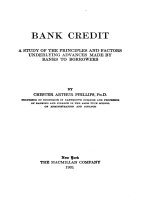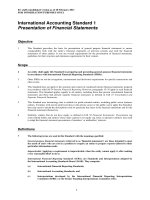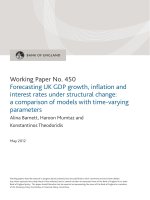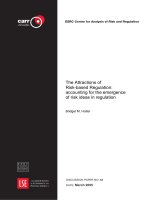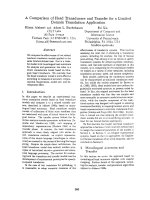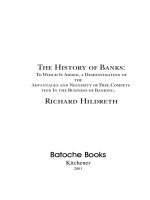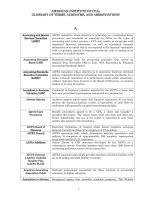International accounting harmonisation - a comparison of Spain, Sweden and Austria docx
Bạn đang xem bản rút gọn của tài liệu. Xem và tải ngay bản đầy đủ của tài liệu tại đây (75.33 KB, 39 trang )
Economics Working Paper
International accounting harmonisation - a comparison of Spain, Sweden and Austria
John Blake *
Oriol Amat **
Catherine Gowthorpe*
Keywords: Accounting, harmonisation, international.
Journal of Economic Literature classification: M41
* Central Lancashire University.
** Universitat Pompeu Fabra
2
International accounting harmonisation - a comparison of Spain, Sweden and
Austria
Abstract
Despite attempts to secure harrnonisation of accounting practice, significant variations in
accounting rules and practice continue to arise in European countries, variations which give
rise to compliance costs for multinational companies.
Firstly, this paper considers the relevance of international accounting harmonisation for
European business. It then proceeds to examine accounting regulation in three countries:
Spain, Sweden and Austria, highlighting the key regulatory issues of the 'true and fair' view
requirement and the link between taxation and accounting. The three countries are selected
because of the interesting contrasts which they provide; these contrasts are examined in
detail in the paper.
The work is based upon a series of interviews carried out with leading accounting
practitioners in the three countries during 1996-97.
The paper concludes that there are significant obstacles to accounting harmonisation in
Europe and that there is potential for continuing diversity of national accounting practice.
3
Introduction:
Despite the effects of governments, through the European Union (EU), and the accounting
profession, through the International Accounting Standards Committee (IASC), substantial
variations in accounting rules and practice continue to arise between different European
Countries. These variations give rise to both financing and compliance costs for European
multinationals. In this paper we report on our discussions with leading accountants in Spain,
Sweden, and Austria on the implementation of the EU 4
th
and 7
th
Company Law Directives on
accounting harmonisation in their countries.
Specifically we:
1. Briefly survey the relevance of international accounting harmonisation for European business,
and the work of two bodies, the EU and IASC, pursuing this objective:
2. Compare the rules of the government and the accounting profession in accounting regulation in
each of the three countries.
3. Analyse the response of each country for the requirement of accounts to give a ‘true and fair
view’ that lies at the heart of the EU 4
th
directive on accounting harmonisation.
4. Consider how each country has adapted the traditional tax-accounting link with the light of EU
harmonisation.
4
The pursuit of harmonisation
Multi-national business has two main reasons to seek international accounting harmonisation:
1. The problems of analysing accounts from different countries increase finance costs in
international capital markets. Choi and Levich (1990, 1991) report on a study of
international investors. In response to the question 'Does accounting diversity affect your
capital market decisions', 9 replied yes, and 7, no.
2. The cost of an accounting system in a multinational is increased both by the cost of
designing, and running different accounting systems in different countries, and the cost of
adjusting accounts from different countries to the accounting system of the country of the
holding company for consolidation purposes. Cecchini (1988) reports on a survey of
European multinational companies showing that different national accounting systems
caused between 10% and 30% of the total accounting costs.
Both these factors hold back the ideal of building a comprehensive and effective free market in
Europe. A third point of interest to the European Union (EU) is to avoid any individual member
state setting low standards of accounting disclosure so as to attract registration of companies
attached to secrecy, at the expense of other EU members. Other parties with a particular interest
in achieving international accounting harmonisation are:
1 “The Big 6” leading international accounting firms, who can achieve substantial savings on
costs of recruitment, training and staff development.
5
2. Developing countries, who by adopting internationally agreed accounting standards save
the cost of devising these at the national level.
There is substantial evidence of international diversity in accounting regulation and practice at
both the European level (see for example Simmonds & Azieres, 1989) and the International level
(see for examples Radebaugh and Gray, 1993, The Economist 1992)
The European Union has pursued harmonisation through three directives on company law:
1. In 1978 the fourth directive laid down requirements for individual company accounts.
2. In 1983 the seventh directive laid down requirements for group accounts.
3. In 1984 the eighth directive addressed the issue of audit requirements.
Van Hulle (1991) summarises the content of the EU 4th Directive:
"The directive itself is a combination of rigidity and flexibility. There is rigidity in: the mandatory
layouts for the balance sheet and profit and loss account; the valuation rules and notably the
limited possibility to depart from the historical cost principle; the minimum content of the notes
and the annual report; and in the audit and disclosure requirements. There is flexibility in: the true
and fair override; the many options both for member states and for companies; the fact that the
provisions of the directive are minimum requirements; and the possibility to derogate from certain
provisions in exceptional cases provided that disclosures are made in the notes on the accounts"
(p.25)
6
The significance of the True and Fair View concept is explored in more detail below. In the
context of the European Union its role has been, along with the range of options, to introduce an
Anglo-Saxon dimension into a directive which would otherwise have had a strong 'continental
European' orientation.
Van der Tas (1988) makes two distinctions between types of accounting harmonisation.
1) Formal harmonisation is harmonisation of the provisions concerning financial reporting.
Material harmonisation is harmonisation of financial reporting practice itself. Other
authorities refer to 'formal' harmonisation as 'de jure' and 'material' harmonisation as 'de
facto'.
2) Disclosure harmonisation is concerned with the extent of information disclosure.
Measurement harmonisation is concerned with the nature of the information disclosed.
Macharzina (1988) observes of the 4th Directive that:
"there is much leeway as regards adoption of accounting, and, in particular, measurement
methods".
Given the EU has achieved a higher level of disclosure than measurement harmonisation, there is a
danger that European accounts will appear similar while having hidden measurement differences.
Montagna (1986) argues:
"The result is a set of weak regulations. Disclosure remains general and vague. There are many
rules but they produce little meaningful information ……….one requirement that would greatly
strengthen the accountability of the international capital markets to investors and the public, the
disclosure of secret reserves, is missing. As the managing partner of a Big Nine Zurich office said,
we will always have harmonisation in areas that are not important" (p. 118).
7
Blake and Amat (1994) offer an analysis of the obstacles to the EU accounting harmonisation at
four levels, as summarised in table 1.
1.The EU itself has failed to produce directives that provide for a comprehensive scheme of
accounting harmonisation. Major areas of controversy have been ignored; thus the EU directives
give no guidance on foreign currency translation, deferred taxation, or accounting for lease
commitments. In other areas individual countries may choose from a range of options; an example
is the permitted range of formats.
2. At the stage of national legislation some countries have interpreted the directives in line with
national accounting traditions. To give two illustrations:
• The German draft law introducing the EC fourth directive offered the comment on the 'true
and fair view' requirement: 'In spite of the pretentious formulation it is supposed that for
practice there will be no principal changes' (Busse von Colbe, 1984, p.123 ).
• In the UK, the minister responsible for implementing the fourth directive announced in
parliament that the UK government was 'at pains to impose the minimum change necessary
in actual accounting practice' (cited in McBarnet & Whelan, 1992, p99).
3. National accounting professions have, on occasion, interpreted national legislation
implementing the EU fourth directive in a conflicting national tradition. Thus while the fourth
directive prescribes that all assets with a finite useful life should be depreciated, a UK standard,
SSAP 19, prescribed annual revaluation instead of depreciation for investment properties.
8
4. At the individual company level there may be failure to comply with the spirit of the rules. As
an example, in Germany some 90% of companies fail to file their published accounts (see van
Hulle, 1993, pp390-l).
Table 1
Obstacles to Accounting Harmonisation in the European Community
Level Obstacles to Harmonisation
European Commission Unresolved issues. Choice of options.
Ambiguous prescriptions.
National legislation Adapted to national tradition. Failure to implement.
National accounting profession Interpretation of national legislation against the spirit of
EU directives
Individual business Non compliance with rules.
The failure of European Union harmonisation is not only apparent at the 'formal' level of the rules,
but also at the 'material' level of actual accounting practice. Table 2 shows, in descending order,
the degree of material harmonisation achieved by eight European countries across nine areas of
measurement practice. Three of the four most harmonised areas in practice are not even covered
by EU directives.
9
Table 2
Extent of harmonisation achieved between 8 EU countries in descending order
1 Translation of the Balance Sheet
2 Treatment of translation differences
3 Inventory valuation
4 Translation of the income statement
5 Depreciation method
6 Research and development
7 Fixed Asset Valuation
8 Goodwill
9 Inventory Costing Method
Source: Herrmann & Thomas, 1995, p264
Professional accounting bodies have gathered together to form the International Accounting
Standards Committee (IASC).
The IASC is run by a board of up to 17 members, having 13 countries nominated by the
International Federation of Accountants (IFAC), and up to 4 co-opted organisations with an
interest in financial reporting. Countries on the IASC board until 31 December 1997 are Australia,
Canada, France, Germany, India, Japan, Malaysia, Mexico, the Netherlands, Nordic Federation,
South Africa, the UK, and the USA. There are two co-opted organisations, the International Co-
ordinating Committee of Financial Analysts Associations and the Federation of Swiss Industrial
Holding Companies (Cairns, 1995). The board meets three times a year, being responsible for the
approval of all exposure drafts and standards as well as the general management of IASC. The
10
board is supported by an advisory council to promote both financing and the use of International
Accounting Standards and by a consultation group of parties with an interest in accounting. The
IASC constitution defines its objectives:-
"To formulate and publish in the public interest accounting standards to be observed in the
presentation of financial statements and to promote their world-wide acceptance and observance.
To work generally for the improvement and harmonisation of regulations, accounting standards
and procedures relating to the presentation of financial statements" (taken from Cairns, 1995, p
1667).
Since 1973 IASC has issued over 30 standards.
Enforcement of lAS's poses a major challenge. Nobes (1995) points out that IASC can only seek
to enforce accounting standards through its member bodies, not by its own authority. In countries
such as France and Germany professional accounting bodies have little influence over the setting
of accounting rules by the government and governmental bodies, and so can only promote lAS's
by persuasion. By contrast in Canada, where accounting standards are issued by the accounting
profession, and enforced by law, it is easy to promote lAS's. Cairns (1989) reports that only 4 of
the countries on the IASC board set their own national standards. In the UK the accounting
profession ceased to control the national process for accounting standards in 1990. It is
interesting to note that:
"From 1993, larger gaps between UK and IASC standards have opened up" (Nobes, 1995, p 84).
Nobes goes on to observe:
"One tell-tale sign of the problems of enforcement is the gradual weakening of the commitments
required from member bodies. At one stage, members were required to use their best endeavours
11
to ensure that companies who broke international standards would disclose this fact. Now the
IASC preface calls for companies that observe the standards to disclose this fact."
The acceptance of international standards by professional bodies who have no control over their
own national standards has been described as 'a symbolic act at best' (McComb, 1982, p 48). Even
where a national accounting professional body issues its own accounting standards, as Benson
(1976) observes:
"Some accounting bodies do not have the power of discipline over their members, and cannot
therefore impose compliance with either national or international Standards" (p 39).
An alternative route to extending the influence of International Accounting standards arises from
the prospect that the International Organisation of Securities' Organisations will give
wholehearted backing:
"IOSCO's acceptance of the lAS's, if ultimately permitted by the individual securities
commissions, would enable international companies that conform to (or reconcile to) the IASC's
rules to engage in multinational securities offerings without complying fully with domestic
accounting rules and regulations. Multinational companies would realise significant cost savings if
they do not have to restate their financial statements to conform to each country's rules when
registering a securities offering" (Wyatt & Yospe, 1993, p 84).
To summarise, there are two bodies driving for accounting harmonisation in Europe. The
effectiveness of IASC depends on the influence of the national accounting profession. The
effectiveness of the European Union depends on a consistent application of the true and fair view.
Harmonisation can be held back by national tax considerations- We now, therefore, turn to a
review of each of these issues in each of our three countries.
12
Sources of Authority
In 1829 the first Spanish Commercial Code was enacted, including detailed instructions on
bookkeeping for business and being strongly influenced by the French Napoleonic Code of 1807.
The accounting requirements of this code were concerned purely with internal bookkeeping
arrangements, and:
“'did not include valuation methods or internal reporting, since at that time the accounts were
considered to be a business secret, knowledge of which was restricted to the owner of the
business and, in the event of litigation, to the judge” (Gonzalo & Gallizo, 1992, p 74).
The code has subsequently been amended in 1885, 1973, and 1989. Only as recently as 1973 was
any regulation put forward applying to the balance sheet and income statement of companies in
general, although certain industries had been subject to accounting regulation earlier, the first case
applying to banks in 1922. The Plan General de Contabilidad (PGC - general accounting plan) of
1973 followed closely the example of the French plan of 1957. Giner Inchausti (1991) analyses
the two key features of this plan as:
1 A strong emphasis on conservatism to protect the interests of creditors.
2 A binding link with fiscal regulations.
To summarise, historically the regulation of accounting in Spain has been through control of the
bookkeeping system rather than the financial statements. We have observed that if Spanish
accountants are asked to explain an accounting rule, their reply will refer to the entries through
the double entry system rather than the impact on the financial statements. Only as recently as
1973 do we find accounting regulation for companies in general that deals with the financial
statements. This regulation was tax based and aimed primarily at creditor protection.
13
As Rivera & Socia's Salva' (1995) observe:
"The real formulation of Spanish accounting principles is a phenomenon of recent vintage, forced
upon Spain by the need to adopt the EU directives to the Spanish circumstances" (p 92).
Following Spain joining the European Union in 1986 the EU directives on auditing and
accounting have been implemented in an auditing law in 1988, a new company law of 1989, and a
new PGC in 1990.
In 1976 responsibility for formulating and adapting the PGC was entrusted to the 'Tnstituto de
Planificaci6n Contable' (IPC) - the Accounting Planning Institute. For twelve years this body, an
autonomous administrative agency under the Ministry of Economy and Finance, produced both
supplements to the main PGC and sectoral plans for industries, where particular accounting
problems arise. In 1988 IPC was replaced by a new 'Instituto de Contabilidad y Auditoria' de
Cuentas' (ICAC) - the Institute for accounting and the auditing of accounts. As the name implies,
this body is responsible both for the role in accounting regulation formerly served by IPC and for
the oversight of auditing. In particular ICAC is responsible for the Registro Oficial de Auditores
de Cuentas (ROAC) - the official register of auditors of accounts.
The two main independent professional bodies for auditors in Spain are:
a) The Instituto de Censores Jurados de Cuentas (ICJCE), founded in 1943, is the longest
established body of its kind, representing Spain at IASC.
b) The Registro de Economistas Auditores (REA), a branch of the Spanish Institute of
Economists, was founded in 1982.
Both these bodies formulate auditing standards, subject to review by ICAC.
14
Alongside these professional bodies for auditors exists a voluntary body, the Asociaci6n Española
de Contabilidad y Administración de Empresas (AECA), founded in 1979. Members include
academics, practitioners in businesses, private practice, and government, audit firms, and
companies. Currently AECA has over 4000 individual and 500 corporate members. AECA
committees produce recommendations in a range of areas including accounting regulation,
company valuation, management accounting, and organisational issues.
Lainez (1994) pays tribute to the success of AECA in the field of accounting regulation:
"In summary, AECA has by its own efforts introduced the dynamism which accounting regulation
has required here in Spain. It has achieved this, on the one hand., by promoting and directly
influencing changes in legislative regulation On the other hand, the documents issued by
AECA cover themes which have not been dealt with in the legislative regulation or, alternatively,
have only been treated in an incomplete way" (p 80).
To summarise, AECA has both had a strong impact on the formulation of the PGC and produces
influential, albeit voluntary, recommendations on areas not covered by legislation. Cañibano
(1992, p 95) reports on a survey by AECA which found that 90% of auditors consider that clients
should follow AECA recommendations.
Sweden is unusual in having three accounting regulatory bodies:
1. There is a professional body for authorised public accountants, the Foreningen
Auktoriserade Revisorer (FAR), founded in 1923. During the mid- 1960's FAR set up a
committee to issue accounting recommendations, and this committee continued its work
until 1989.
15
2. A governmental body under the Ministry of Justice, Bokforingsnamanden (BEN), the
Accounting Standards Board, was set up in 1976. Most BEN recommendations are on
the detailed application of the internal accounting records. There have also been
occasional recommendations on external financial reporting issues, the most notable being
on foreign currency translation (Jonsson & Marten 1995).
3. In 1989 FAR and BFN joined together with the federation of Swedish industries to
support a new body, Redovisningsrade (RR), the Financial Reporting Council. RR issues
standards for public companies listed on the Stock Exchange. Since 1989 both FAR and
BEN have not issued new recommendations on Financial Reporting, but their old
recommendations remain in force.
The Accounting Act requires companies to follow 'God Redovisnings Sed' (GRS), Good
Accounting Practice. Practitioners we spoke to referred to this as 'Swedish GAAP', on implicit
comparison with the US requirement that companies follow 'Generally Accepted Accounting
Principles'. In fact, there are substantial differences between the US concept of 'GAAP', which
draws on a hierarchy of official recommendations headed up by the standards issued by the
Financial Accounting Standards Board (FASB) (see Sunter 1991) and GRS in Sweden. 'GRS' in
Sweden arises when two conditions are met:
1) A practice is specified by one of the three bodies discussed above.
2) A representative sample of leading companies follow the official recommendation.
Thus to achieve the status of 'GRS' in Sweden an accounting recommendation must both come
from an authoritative body and be accepted by a number of companies. Accounting regulators
16
cannot, as in the US or UK, impose a standard against the views of the business community. An
interesting aspect of this system is that recommendations of RR, designed for listed companies,
will, if accepted, become 'GRS', and therefore apply to all companies.
Another important difference between 'GRS' in Sweden and 'GAAP' in the USA is that Sweden
has a substantial body of accounting and tax law, all of which ranks above GRS (Westermark
1989).
Overall, practitioners we spoke to felt that the Swedish legislation had implemented the EU
directives in a very narrow and prescriptive way, following the German approach. They would
have preferred the government to allow the full range of options and discretion permitted in the
directives, as they felt had been the case in Denmark. They saw the most important influences on
Swedish accountants as, in order., the International Accounting Standards Committee, the USA,
and the UK. Indeed, one practitioner observed that he read all documentation from the UK
Accounting Standards Board and took this as guidance on areas not covered by accounting
recommendations in Sweden.
Thus the implementation of the EU directives in Sweden, with its emphasis on a prescriptive tax-
driven accounting system in the German tradition, was a disappointment to practitioners. To
illustrate this with some quotes from practitioners on this implementation:
“Quoted companies would prefer Anglo-Saxon solutions rather than the approach offered by the
Fourth Directive”.
"The European Union has pushed Swedish accounting towards a German approach which is a pity
and old fashioned in a number of ways".
"The Swedish government overreacted to the demands of the EU".
17
"A retrograde step".
"A step back from our move towards International Accounting Standards".
"A step back towards an extreme prudent view".
It is striking that Swedish accounting practitioners, committed to international accounting
harmonisation, have found application of the European Union directives on accounting
harmonisation such a negative experience.
The first accounting law in Austria was enacted in 1768, the Holkedret, which required all
merchants to keep accounts (Novotny & Gruder, 1993). Subsequent accounting laws include the
1863 General Commercial Law (Allgemeines Handelsgesetzbuch) which was drawn up by
delegates of all of the states of the German confederation, and the German Commercial Law
(Deutsche Handelsgesetzbuch - dHGB) which was introduced into Austrian law after the 1938
Anschluss. Even after the Austrian State Treaty of 1955 the German legal influence persisted
unabated; the Austrian Companies Act (Osterreichisches Aktengesetz) of 1965 was based upon
the German equivalent of 1937.
More recently, Austrian accounting law has changed substantially in order to bring it into line with
EU requirements. Although Austria applied formally to join the European Community only in
1989 the main provisions of the harmonising law were enacted in 1990, via the Accounting Law
(Rechnunglegungsgesetz - RLG), and so Austria started on the road to harmonisation of
accounting law some time before it actually joined the EU. Austria was undoubtedly helped in this
by the existence of German law which it adopted with few amendments.
A further harmonising law is being enacted in Austria during 1997, and this will complete the legal
process of harmonisation. These changes in the law have meant radical changes to accounting.
Several of our interviewees referred to the poor information content of accounts prior to the new
18
laws; for example, there used to be no figure for turnover in the profit and loss account and the
gross profit figure which was disclosed was not comparable from one company to another.
Another significant change relates to group accounting, which was introduced in Austria in 1994.
The result of all the recent changes is that Austrian accounts now bear a much closer resemblance
to those produced elsewhere in Europe, but the process of harmonisation has required a very
rapid evolution of thinking and practice in accounting, the effects of which will take many years to
assimilate. Austrian accountants have not been accustomed to preparing accounts which have a
high information content, or which are expected to provide decision-useful information to a wide
range of users.
There are two main accounting bodies in Austria; the Chamber of Public Accountants and the
Institute of Austrian Certified Accountants. All qualified accountants are members of the
Chamber, which represents the profession and acts on behalf of its members. Some 80-90% of
accountants are also members of the Institute (Wagenhofer, 1996) which is responsible for
technical matters. The period of training and education for the full auditor (Wirtschaftsprufer)
qualification is long and arduous, as in Germany. There is a lower level qualification
(Steuerberater) which is an intermediate step between university level qualification and
Wirtschaftsprufer. Holders of this intermediate qualification may practise as accountants but are
not permitted to audit. The two professional organisations produce opinions and guidelines on
accounting and auditing issues; these are not standards because they are not, strictly speaking,
mandatory, but they do have considerable persuasive influence.
The most important objective of Austrian accounting is, and has been historically, the protection
of creditors, which has led to a very conservative tradition of accounting. A second and much
more recently established objective, the provision of information, has been given impetus by two
factors: firstly, a series of highly published bankruptcies in the 1980s, and secondly, the
introduction of harmonising legislation. An example of the alteration in emphasis is the
introduction of group accounting via the RLG 1990 which has its main objective the provision of
information.
19
In Austria sole traders and partnerships are a legal form of business entity and come within the
scope of the Commercial Code which requires all forms of legal entity, both incorporated and
unincorporated, to keep good accounting records and to prepare accounts. There are two
important concepts underlying current Austrian accounting: the "true and fair view" and
"good accounting practice" (Grundsatz ordnungsmassiger Buchfuhrung).
GoB, good accounting principles, are implemented by reference to several sources including the
Commercial Code, accounting literature, the courts and from day to day practice (Wagenhofer,
1996). Apart from the general requirement that accounts should be prepared in accordance with
GoB there are general concepts set out in the law: for example, clarity, consistency, up to
dateness, going concern, valuation of assets and liabilities individually, and prudence. Other
concepts derive from accounting literature for example, the accruals concept and materiality.
However, GoB are dynamic principles; although some elements of the principles are established in
law and accounting literature, they tend to develop over time through commercial practice
combined with prescription in law. Our interviews indicated that these principles are recognised
and agreed upon by accountants, without necessarily being expressly enshrined in regulation: for
example: "Naturally, there are books about it, and there are lectures on it at the University, but
in practice it's in your head".
There is an interesting contrast between our three countries. Spain has experienced a major
change in the thrust of national accounting regulation driven by a voluntary association of
practitioners. In Sweden practitioners have not achieved implementation of the EU directives in
the spirit they would prefer. In Austria, practitioners have less influence both on legislation and
through accounting recommendations. Table 3 summarises some key aspects.
20
Table 3
Spain Sweden Austria
Regulation
High, both on
legislative and through
own recommendations
Low on legislation,
High throug own
recommendations
Low
Spirit in which EU
directive is
implemented
Anglo-American bias Continental European
bias
Continental
European bias
Accountants view of
how EU directives
have been
implemented.
Satisfied Disappointed Satisfied
The true and fair view
The EU 4th Directive requires:
1) That company accounts should present a true and fair view (TFV).
2) That where compliance with specific legal requirements does not, in itself, result in the
provision of a true and fair view then additional information must be given in the accounts
to achieve that end.
3) In 'exceptional cases' companies should not comply with specific accounting rules where
this is necessary, in order to provide a true and fair view. This is referred to as the TFV
'override'.
21
Spain has incorporated all three of these requirements in it's company law. In Sweden and Austria
only the first two have been adopted; neither country has accepted the TFV override.
The term 'true and fair view' first appears in legislation in the UK Companies Act of 1947. It has
never been defined in either UK or European law, and a range of meanings can be attached to it.
Thus, one study concluded 'True and fair is what you make it." (Chastrey 1975 p92). Higson and
Blake (1993) identify four distinct, and sometimes conflicting, elements in the term:
1) It appears that originally accountants lobbied for the term 'true and fair' to replace the
previous term 'true and correct', on the grounds that the latter term implied an
unachievable degree of precision. Thus the term was seen as a relaxation of the
accountant's duty.
2) Conversely, the term has been seen as adding to the accountant's duty in that accounts
must not only present the literal truth but also comply with the spirit of the law to give a
'fair' view. As Benson (1989) argues: "In effect substance took precedence over form".
(p45)
3) 'Fairness' has also been taken to imply that accounts should be free from bias, giving as
objective a picture as possible.
4) Another aspect of the term is that it has been regarded as giving authority to official
pronouncements from the accounting profession, such as the Financial Reporting
Standards (FRS's), and Statements of Standard Accounting Practice (SSAP's) issued in the
UK.
When the UK joined the European Union in 1973, a first draft of a directive on company accounts
had already been formulated. This followed the French and German tradition of rigid and detailed
22
rules on accounting procedures and disclosures. UK accountants lobbied successfully for both the
TFV requirement and a range of options to be brought into revised drafts. Together these changes
allowed the UK to retain its traditional flexibility in accounting approaches. One leading UK
auditor summed up the spirit of the UK profession with the observation "we seem to have
managed to stitch the rest of Europe up under true and fair now" (Higson & Blake 1993,p113).
The Spanish practitioners we spoke to were agreed in welcoming the 'true and fair view'
requirement, which translates into Spanish as 'imagen fiel' - 'faithful picture', -an adoption of the
French official translation 'image fidele'. Some use of the TFV override appears to be made in
Spain. Navarro Gomollon (1995) reports that in a sample of 49 unqualified audit reports, two
refer to use of the override. In a survey of 150 company accounts Ernst & Young (1995) give
four examples of use of the override. We put two examples of possible cases for use of the
override to Spanish auditors:
1) The deduction of the unamortised discount on a deep discounted debenture from the
nominal value of the debenture rather than showing it as an asset, the latter being the
treatment in the Spanish PGC. We chose this as an example of use of the override which
we had seen in a Spanish company's accounts, and therefore, saw as a defensible use of the
override.
2) An 'in substance defeasance of debt' transaction, whereby a company had bought
government securities and placed them in an irrevocable trust to cover the payments of
interest and principal on a loan. The PGC, applying the 'no set off' rules of the fourth
directive, would require both the liability and the assets to be shown in the accounts. We
asked whether the alternative treatment, of removing both the liability and the related
assets from the Balance Sheet, could be justified by the override. We chose this as an
extreme case, where use of the override has only been tentatively suggested as a possibility
(see Walton 1985).
23
Auditors were evenly divided as to whether they would agree with use of the override in the first
case, and unanimous in rejecting the second case. To summarise, Spanish auditors seem to
welcome the principle of the true and fair view but to be cautious in use of the override.
In Sweden, TFV has been translated as 'rattvisande bild', a term which interviewees were agreed
in translating as 'a fair view'. The translation has not given rise to controversy. Sweden has not
adopted the TFV override.
Practitioners we spoke to were divided on the issue as to whether they would wish to see such an
override provision in the law. On the one hand those in favour argued:
1) An override would help companies wishing to override some particularly inflexible aspects
of accounting law. An example cited is that some ten companies currently show listed
investments at market price, a practice that will not be allowed under strict historic cost
rules in the new Act.
2) An override would also help companies comply with International Accounting Standards.
An example is that the law does not permit foreign exchange translation gains to be taken
as profit.
3) The override would be useful as a tool against creative accounting. The example of some
'creative' sale and leaseback deals on real estate was mentioned.
4) As the Accounting Act becomes older, new circumstances not envisaged in the Act may
arise that make an override useful. An example is the complexity of some new financial
instruments.
24
Against this, some practitioners saw the concept of an override provision as alien to the Swedish
tradition, while extra disclosure should be an adequate solution. Two practitioners felt that
ambiguity in application of an override could give rise to conflict between client and auditor.
In Austria, an early translation of a true and fair view appeared in the Public Corporations Act
(Aktiengesetz -AKtG), the forerunner of the current Commercial Code, and the RLG 1990. The
AKtG translated "a true and fair view" as "ein moglichst sicherer Einblick" which translates back
into English as "a surest possible insight". This translation was criticised for enabling a tradition of
interpretation to be established (Novotny 1992). In addition the work "sicher" implied caution
and suggested that values were uncertain and indeterminable in the future. (Altenburger, 1989,
quoted by Loidl, 1994). The translation of a true and fair view introduced in the Commercial
Code by the RLG of 1990 and currently used in Austria, is "ein moglichst getreues Bild" which
translates literally as "a truest possible picture".
One interviewee, commenting on the close relationship between German and Austrian accounting
law, illustrated the point with the example of the RLG 1990; when this Act was written the law
makers simply took the German Financial Reporting Act almost word for word leaving out only
those sections relating to shipping law which, as Austria no longer had a coast line, were not
relevant. It is noteworthy, however, that these two closely linked accounting communities
translated "true and fair view" differently. In Germany the translation is "ein den tatsachlichen
Verhalttnissen entsprechendes Bild" (s 264 Deutsches Handelsgesetzbuch - dHGB). This
translates literally back into English as "a picture according to the facts". This translation was not
taken into Austrian law because it was felt that there would be a danger of misunderstanding, and
that the principles and the law cannot mirror the facts (Nowotny 1992). Practitioners, when asked
why there were different translations for "true ~rnd fair view" in Austria and Germany, supported
this explanation. One interviewee opined that the Austrian "ein moglichst getreues Bild" is more
in line with the French 'fidele" and that it reflects the meaning of "true and fair view" better than
the German translation. The same practitioner also had the impression that the German
25
accounting community is not happy with their translation. Another practitioner pointed out that
the use of the word "facts" in the German translation was too strong:
“”Moglichst getreu”is better because the framework of valuation principles which we have
means that you cannot present a picture which corresponds with the actual circumstances…”
An opinion expressed by another practitioner was that the Austrian translation in contrast to the
German translation introduces the concept of materiality. It is worth noting too, that there have
been no cases in the Austrian courts which test out the significance of "ein moglichst getreues
Bild", and so in all instances, the matter is to some extent one of personal interpretation.
However, it is significant that the issue of translation has been given so much thought in a country
where commercial law is usually adopted without significant change in Germany.
Although it would appear that there is a linguistic difference between the German and the
Austrian translations of "true and fair view", in terms of its understanding in the law there appears
to be no difference between the two interpretations of the expression. The two translations are
recognised by practitioners and in the literature as being comparable. Neither Austrian nor
German law has adopted the true and fair view override which permits the detailed provisions of
the law to be set aside in order to enable the financial statements to present a true and fair view,
even though this override is specifically part of the Directive. German and therefore Austrian law
follows the Roman law approach whereby a specific rule takes precedence over a general rule and
so, if there is a conflict between a specific legal principle and the general principle of "true and fair
view" then a business entity must not depart from the specific rule. However, if the entity is a
limited company details of the conflict must be given in the notes to the financial statements
(Wagenhofer, 1996). None of our interviewees regarded the absence of the override provision as
a problem in Austrian accounting, and indeed would not welcome its introduction:
" if you have an exact provision you don't need any in-depth discussions with the client. I hate
these discussions. I like to say to the client: 'here is the law: you must follow it'. If you ask five
